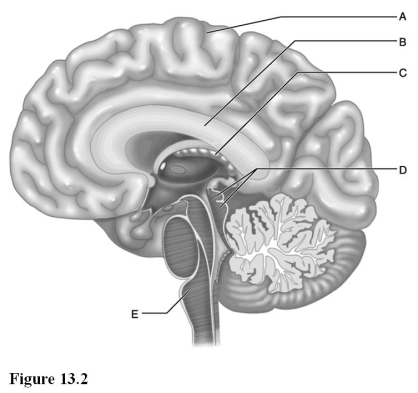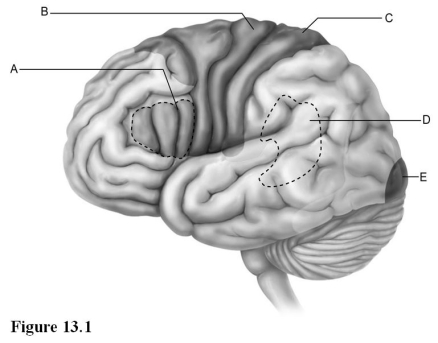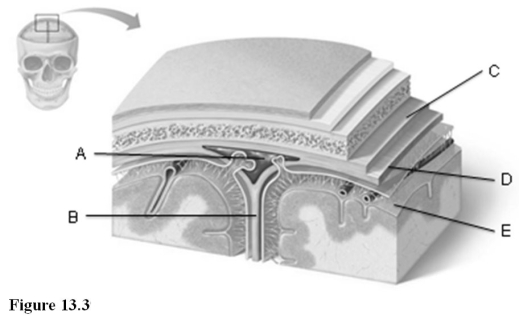A) how smells bring about emotions.
B) the function of the hypothalamus in controlling sleep.
C) the function of sensory input to the reticular activating system.
D) how smells elicit memories of being awake, causing the person to awaken.
F) A) and B)
Correct Answer

verified
Correct Answer
verified
Multiple Choice
 Use the diagram above to answer the following questions.
-Which letter indicates the region of the brain that has the greatest surface area due to the numerous surface convolutions?
Use the diagram above to answer the following questions.
-Which letter indicates the region of the brain that has the greatest surface area due to the numerous surface convolutions?
A) A
B) B
C) C
D) D
E) E
G) D) and E)
Correct Answer

verified
Correct Answer
verified
True/False
The cerebellum has an outer cortex of gray matter, internal white matter, and areas of gray matter embedded in the white matter.
B) False
Correct Answer

verified
Correct Answer
verified
Multiple Choice
Sleep-wake cycles are controlled by the pineal gland and the
A) hypothalamus.
B) medulla oblongata.
C) thalamus.
D) visual cortex.
F) A) and C)
Correct Answer

verified
Correct Answer
verified
Multiple Choice
Which of these regions of the brain regulates hormonal secretions from the pituitary gland (hypophysis) ?
A) hypothalamus
B) cerebrum
C) cerebellum
D) thalamus
F) A) and D)
Correct Answer

verified
Correct Answer
verified
Multiple Choice
The hindbrain of the embryo develops into the pons, the medulla oblongata, part of the spinal cord, and what other structure?
A) hypothalamus
B) cerebrum
C) cerebellum
D) thalamus
F) B) and C)
Correct Answer

verified
Correct Answer
verified
Multiple Choice
 Use the diagram above to answer the following questions.
-Which letter indicates the corpora quadrigemina, meaning "four bodies"?
Use the diagram above to answer the following questions.
-Which letter indicates the corpora quadrigemina, meaning "four bodies"?
A) A
B) B
C) C
D) D
E) E
G) A) and E)
Correct Answer

verified
Correct Answer
verified
Multiple Choice
The main visceral control center of the brain is the
A) cerebral cortex.
B) thalamus.
C) reticular formation.
D) hypothalamus.
F) C) and D)
Correct Answer

verified
Correct Answer
verified
True/False
The surface of the cerebellum is folded into ridges called folia.
B) False
Correct Answer

verified
Correct Answer
verified
Multiple Choice
Which of the following is associated with Alzheimer's disease?
A) accumulation of protein plaques around neurons
B) cerebral ischemia
C) deterioration of the substantia nigra of the midbrain
D) inadequate vitamin B
F) A) and B)
Correct Answer

verified
Correct Answer
verified
Multiple Choice
 Use the diagram above to answer the following questions.
-Which letter indicates an area that is characterized by huge neurons known as pyramidal cells?
Use the diagram above to answer the following questions.
-Which letter indicates an area that is characterized by huge neurons known as pyramidal cells?
A) A
B) B
C) C
D) D
E) E
G) B) and C)
Correct Answer

verified
Correct Answer
verified
Multiple Choice
The calcarine sulcus contains which functional area?
A) primary somatosensory
B) auditory association
C) frontal eye field
D) primary visual
F) C) and D)
Correct Answer

verified
Correct Answer
verified
Multiple Choice
 Use the diagram above to answer the following questions.
-Which letter indicates a choroid plexus, which produces cerebrospinal fluid (CSF) in all four ventricles of the brain?
Use the diagram above to answer the following questions.
-Which letter indicates a choroid plexus, which produces cerebrospinal fluid (CSF) in all four ventricles of the brain?
A) A
B) B
C) C
D) D
E) E
G) D) and E)
Correct Answer

verified
Correct Answer
verified
Essay
Briefly identify the role of the following structures in controlling voluntary skeletal movement: cerebellum, primary motor cortex, premotor cortex, pyramidal tracts, inferior olivary nucleus, and cerebral and cerebellar peduncles.
Correct Answer

verified
The premotor cortex and primary motor co...View Answer
Show Answer
Correct Answer
verified
View Answer
Short Answer
Cerebrovascular accident is a long name for what type of brain injury?
Correct Answer

verified
Correct Answer
verified
True/False
The meninges of the brain differ from those of the spinal cord in that the dura mater of the brain splits into two layers and that there is no epidural space.
B) False
Correct Answer

verified
Correct Answer
verified
Multiple Choice
All of the following are structures of the limbic system except the
A) hippocampus.
B) cingulate gyrus.
C) amygdaloid nucleus.
D) caudate nucleus.
F) A) and B)
Correct Answer

verified
Correct Answer
verified
Multiple Choice
 Use the diagram above to answer the following questions.
-Which letter indicates the periosteal layer of the dura mater?
Use the diagram above to answer the following questions.
-Which letter indicates the periosteal layer of the dura mater?
A) A
B) B
C) C
D) D
E) E
G) D) and E)
Correct Answer

verified
Correct Answer
verified
Multiple Choice
Which of these regions functions to direct nearly all sensory input, except olfactory impulses, to the cerebral cortex?
A) hypothalamus
B) cerebrum
C) cerebellum
D) thalamus
F) A) and B)
Correct Answer

verified
Correct Answer
verified
True/False
The pituitary gland (hypophysis) is connected to the hypothalamus and receives regulatory impulses that control the secretion of hormones.
B) False
Correct Answer

verified
Correct Answer
verified
Showing 41 - 60 of 109
Related Exams